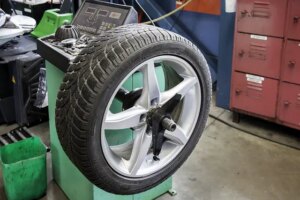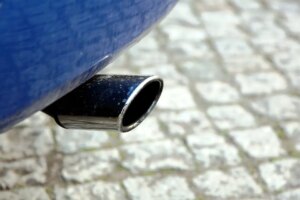
Hearing an unexpected humming noise when taking your foot off the accelerator can be a stressful and unpleasant experience. Unfortunately, there are quite a few issues that can cause such a problem. And while some are a relatively easy fix, others can be a lot more serious.
You might hear a humming noise when releasing the gas pedal if your car has loose or damaged engine mounts. It could also be worn suspension or drivetrain components. Issues with the exhaust system, like a loose heat shield or leaks, might also be to blame. In some rare cases you may need to hire a qualified mechanic.
Below, you will find out how to tackle the problem yourself and when it would be worth leaving the job to the professionals. Let’s get started!
Why Do I Hear a Humming Noise When Taking Foot Off Accelerator?
1. Loose or damaged engine mounts
As you take your foot off the gas pedal, the engine acts as a ‘brake’. This means that it wants to move in the opposite direction.
The vehicle’s engine is held in place by quite a few mounts that, in their turn, attach the component to the car’s frame. One of the mounts can eventually become loose or get damaged. When you take your foot off the gas pedal in such a case, the engine will tilt, and you will hear the noise.
If you notice a very slight vibration while sitting in your parked vehicle with the engine running, it’s likely that the engine mounts are the root cause of the problem.
2. Issues with the exhaust system
In the case there is a worn or broken mount or heat shield, the engine tilt (that happens once you remove your foot from the accelerator) will cause contact between the steel and tin components. The heat shield can sometimes become loose, but such an issue will cause a noise when the car is in motion, not only when you drop the gas pedal.
Also, do bear in mind that leaks in the exhaust system can cause all sorts of sounds when you release the accelerator.
3. Worn or damaged suspension components
Suspension systems maximize the friction between the vehicle and the road. This allows the frame and the body of the car to remain stable so that you experience more comfortable handling.
The components of the system naturally undergo a lot of stress as their main aim is to absorb any impacts from uneven roads. Thus, over time, the various components will wear down or even get damaged, which might lead to different noises.
Finally, the muffler might be worn out. If there is something wrong with this component, the exhaust will become louder, the engine might start to misfire, and the exhaust pipe may start to drip.
4. Worn or damaged drivetrain components
A vehicle’s drivetrain includes all the components that transfer the engine’s energy to the wheels, in order to make the car move. This includes the transmission, differential, axles, driveshaft, CV joints, and the actual wheels.
Any of these components can wear down over time and cause a wide range of noises. When it comes to the transmission, a failing torque converter or a worn-out clutch is usually to blame.
5. The noise is a short-term result of tire rotation

If you have recently rotated your tires, then that might be the reason for the noise (though you will, most likely, hear it not only when you release the gas pedal).
Thankfully, if that’s actually the issue, the sound should go away once the tires start to wear down the existing uneven wear patterns. However, if the noise is very loud, then you might have to get your alignment checked.
How to Fix Humming Noise When Taking Foot Off Accelerator
It is extremely important to have the issue diagnosed and fixed as soon as possible if you’re hearing a humming sound when you release the gas pedal. Though the noise might not seem like a huge inconvenience at first, it might end up leading to serious damage and even safety concerns.
Ideally, you would want to immediately take the vehicle to a qualified mechanic. But if you’re an experienced DIYer, then there are a few easy fixes that you might want to try out first.
Install a New Heat Shield
You can use a metal clamp to secure the heat shield component in place if it is loose. But do bear in mind that it’s only a temporary fix, and the heat will, most likely, soon snap the metal clamp in half.
That’s why you might want to:
- Remove the heat shield.
- Install new spacers, bolts, and washers.
To create a spacer and washer, you may want to use the rubber bushing from a shock absorber, for example. You can secure the rubber to the heat shield by using high-temperature RTV silicone. After that, place the washer over the bushing, and put the washer on the other side of the heat shield. - Put the heat shield back in place. Use a bolt to secure the component. To protect the new bushings from the heat, you might want to attach double washers.
Replace the Muffler
A damaged muffler might be producing relatively loud noises. And though installing a new component would involve lifting the car and, perhaps, even sawing the muffler off, it can be a fairly easy and cost-efficient project for experienced car owners.
- Jack up the car and locate the muffler (it is usually located close to the rear of the vehicle).
- Use a wrench to remove the bolts or clamps. If the muffler is welded, you might have to saw it off (leave at least 2 inches of pipe; those will fit into the new component).
- Install the new muffler. Each component comes with indications that show where the front and the back are. Make sure that the pipe connections are tight. Otherwise, even the new component will be noisy and there will be a good chance of leakage.
- Clamp or bolt the muffler into place. Ensure that it is not hanging too close to the ground. If you have sawed the component off, you would have to either weld the muffler into place or clamp it firmly.
Find and Fix the Exhaust Leaks

An exhaust leak can easily affect the performance of the engine and cause increased noise, especially when accelerating.
However, before fixing any exhaust leaks, you would have to find them. Make sure to do that once the vehicle has been off for at least a few hours as the exhaust pipes can be very hot.
Leaks can typically be located in one of these areas:
- On the manifold
- On the downpipe/catalytic converter
- On the mounting surface of the engine
Simply feel around the pipes for any air leaking out. If there really is a leak, the fixing solution would depend on the area where it’s located.
For leaks at the manifold or joints, you would have to replace the failed gasket. Just make sure to use a wire brush to clean the surfaces before installing a new gasket.
If the leak is located on the catalytic converter, then you would have to replace the component. Epoxy bonds and tape can become a temporary fix for an emergency situation, but they will only last a short amount of time.
Frequently Asked Questions
Why Does My Car Make a Humming Noise When Picking Up Speed?
Depending on where exactly the sound is coming from, you might be dealing with:
- Bad ball joints
- Worn or damaged bearings
- Faulty CV joint
- Lack of engine oil
- Cracked serpentine belt
- Incorrect cylinder compression
- Issues with the transmission or engine
Why Is My Gas Pedal Vibrating?
One of the most common reasons for a vibrating gas pedal is out-of-balance rear tires. The vibrations can also arise due to faults associated with wheel bearings, axles, calipers, driveshafts, and motor mounts.
Why Does My Car Make a Sound When I Put My Foot on the Gas Pedal?
If the engine mounts wear out, they won’t be securely holding the engine in place. As a result, the components will come in contact with other metal elements as soon as you press down the accelerator.
By the way, a loud or squealing noise might mean that there is an issue with the engine belt (the component is loose or worn or one of the belt’s pulleys started to fail).
To Sum Up
Humming noise when taking foot off accelerator can be caused by a wide range of factors. Issues with the exhaust system and loose or damaged engine mounts are among the most common root causes.
Do bear in mind that even if the noise is not loud, you have to try to take care of the issue as soon as possible. Though you can replace the muffler and secure a loose heat shield yourself, it is generally recommended to let the professionals diagnose and solve the problem. Failure to address the noise can lead to serious vehicle damage and even accidents.






![Why Is There a Rattle When I Accelerate? [Help & Advice] gas-station-wrong-octane](https://wpbmobility.com/wp-content/uploads/2023/12/gas-station-wrong-octane-300x161.png)






